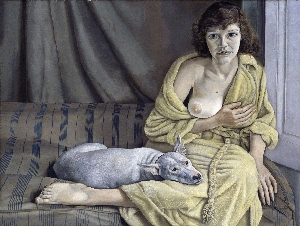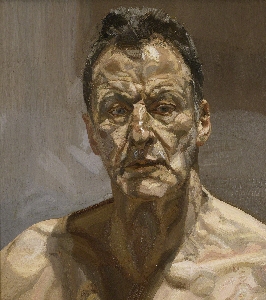12/02/12
Lucian Freud Portraits
National Portrait Gallery
9 February – 27 May 2012
‘Everything is autobiographical and everything is a portrait, even if it’s only a chair.’ And yet despite, or maybe precisely because of, such a frank attitude towards his works, the exhibition marking the culmination of the National Portrait Gallery’s Cultural Olympiad is the first show of Lucian Freud’s (1922 – 2011) works to focus solely on his portraiture, in the true sense of the word.
Spanning seven decades, from the early 1940s until his death last July, the exhibition showcases 130 paintings and works on paper, including both iconic and rarely-seen paintings of his lovers, friends, and family, each a record of an intimate relationship, personal and private. The idea for the exhibition initially came about following a conversation between Sandy Nairne (Director of the National Portrait Gallery) and Freud, in 2006, after it was known that London would host the 2012 Olympics, and the artist was keen for it to be one of the capital’s countdown events for the London 2012 Festival.
The works on display are arranged broadly chronologically, and trace Freud’s stylistic development. The first rooms are filled with his early works – smoother, flatter, more evenly toned than the Freud we later came to know and expect. This was the period when he was learning to paint, and his subjects are primarily himself and his first wife, Kitty Garman, the daughter of sculptor Jacob Epstein. He has described himself, during this period, as ‘aggressive’ in his approach, moving from feature to feature, using a very fine brush (half the size of his little finger), to achieve intricate, almost forensic, detail. Garman described the experience of sitting for him as ‘like being arranged’, yet her grip on the rose (Girl with Roses, 1947-8) and kitten (Girl with a Kitten, 1947) is, in each instance, so tight, it is almost strangling. Was this Freud’s intent, or more a reflection of herself and her anxiety? In each picture, her gaze looks out sideways beyond the viewer, almost vacantly. In the slightly later Girl with a White Dog (1950-1), however, with its disturbing, but recognisably Freudian, green tinge, she faces forwards, staring directly both at and through the viewer – and therefore also the artist himself – almost defiantly. This is perhaps a sense of foreboding of the couple’s coming separation.

Freud was a painter of personality, capturing the character of his sitters, their psychology, rather than, necessarily, a physical likeness (although each and every one of his sitters is, nevertheless, easily recognisable). He was a master of capturing expressions and moods, as, for example, in A Young Painter (1957-8), of whom one wonders, with his rumpled brow and parted lips, what it is he is feeling: consternation, anger, concern? Similarly, Head of a Child (1954), with its wide eyes and open mouth, cries out with terror, fear, and anguish.
Woman Smiling (1958-9) marks the transitional moment in Freud’s career, at which he first stood up to paint (and never again sat down). He simultaneously also began using thicker, horse hair, brushes, and introducing a more varied palette, with less blending, and more vigorous brushstrokes. ‘As far as I am concerned the paint is the person. I want it to work for me just as flesh does.’ Freud had a fascination with the landscape of the skin and reputedly claimed there to be no such thing as bland or generic skin, and not even his portrait of his baby daughter, Bella, (Baby on a Green Sofa, 1961), spares the subject from his keen observation. As fellow artist (and sitter) Frank Auerbach (born 1931) has said, Freud’s work is ‘raw, not cooked to be more digestible as art…’
Freud’s portrayals are honest to the point of brutality. Take, for example, his portrait of John Deakin (1963-4), a chronic, red-faced, alcoholic with prominent ears; Man in a Blue Shirt (1965), a portrait of George Dyer, Francis Bacon’s lover, who later committed suicide, unashamedly revealing his hare lip and broken nose; and A Man and his Daughter (1963-4), depicting a bank robber who lived beneath the artist in Paddington, with livid scars across his face. It is unsurprising, then, to learn that Freud believed that if a painting didn’t have some drama to it, it was nothing more than paint out of a tube.
Yet there is also a tenderness to his paintings. Pregnant Girl (1960-1), a portrait of Bernadine Coverley, the mother of Bella, shows her with her head turned to the side on the pillow, breasts exposed, collar bones prominent, shoulders rounded, wisps of dark hair falling across the porcelain skin of her face – a sentimental expression of beauty and fragility.
Freud’s models often assumed unusual and uncomfortable poses, and he always required the sitter to remain present even whilst he was painting the background, fully aware of their impact on the space. ‘I work from people that interest me and that I care about, in rooms that I live in and know.’
The show would not be complete without including some of Freud’s portraits of Leigh Bowery, the performance artist, large, majestic, monumental paintings, but hung here in a small, intimate side room, selected, according to curator Sarah Howgate, to convey the size of the studio in which the works were made, and, of course, of Sue Tilley, the amply proportioned benefits supervisor who featured in a number of portraits in the mid 1990s.

The final room, of his later works, contains nudes which are gritty in all senses: their subject matter as brutal an exposure as ever, but also the texture and surface of the work – it is almost as if he had mixed some substance into the oil paint to create a raised and undulating fleshy surface. The show concludes, however, with an unfinished portrait of his gallery assistant, David Dawson, and his dog Eli, Portrait of the Hound (2011), on which Freud was working until shortly before his death on 20 July 2011. Nairne is keen to emphasise, however, that the show was planned, until very near the end, with the collaboration of Freud himself, and, as such, it is very much a ‘living exhibition’, not a memorial. Indeed, for an artist who imbued each portrait with so much energy, character, and life force, what else could it be?
Girl with a White Dog (1950-1)
© Tate, London 2012
Reflection (Self-portrait) (1985)
Private Collection, Ireland
© The Lucian Freud Archive
Photo: Courtesy Lucian Freud Archive